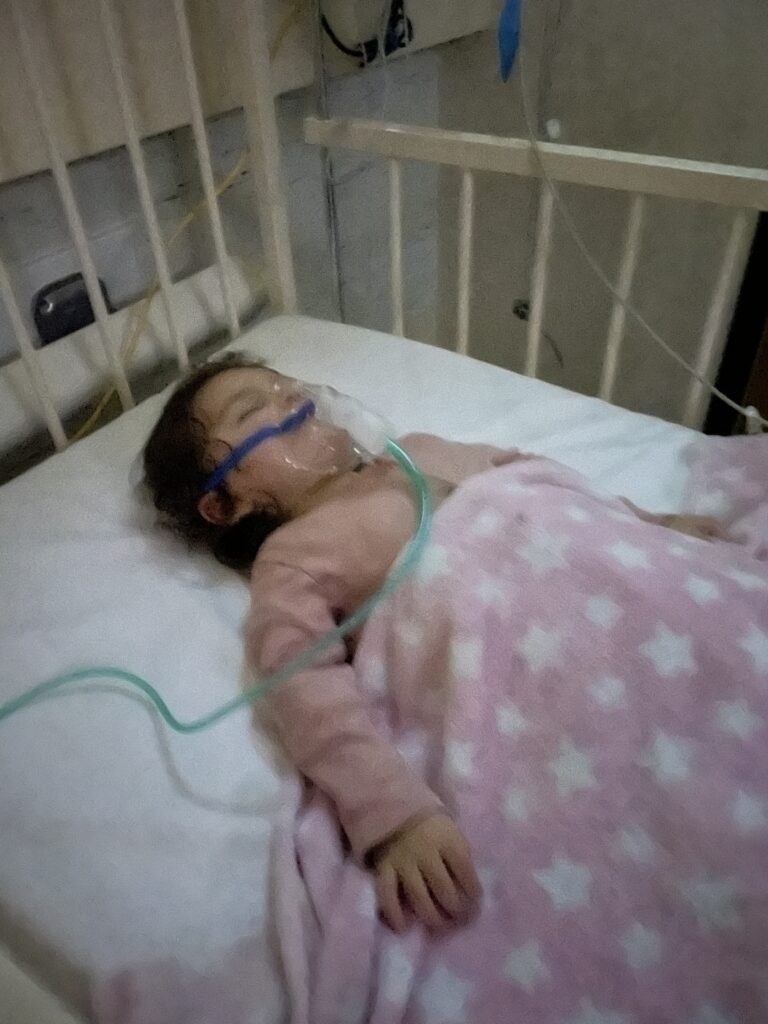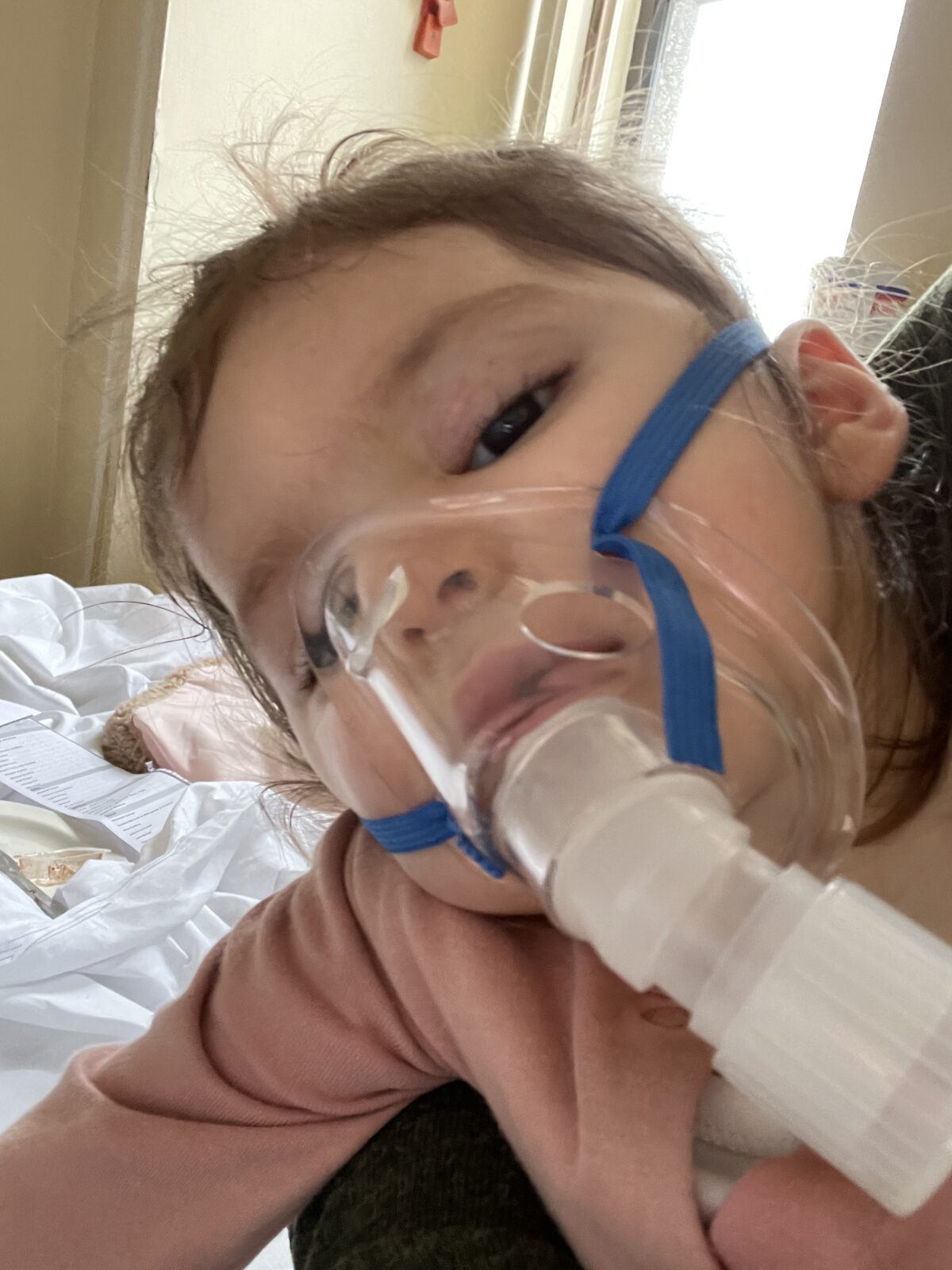We all get sick from time to time, especially at this time of year. Children seem to be breeders of these pesky little viruses. Usually, we can shake off a common cold with little to no downtime. But what happens when a compromised child gets sick?
My daughter, Avery is 19 months old. She has Cerebral Palsy caused by a severe hypoxic event when she was just three days old.
Avery’s body and mind has to work so much harder than a neurotypical child’s to do even the simplest of things that most (including me) take for granted. She is also g tube fed – and an open stoma can be a sitting duck for infections, even if you’re very clean.
Avery has had her fair share of illnesses, as a matter of fact, I would say she is poorly more than she is well. It takes her longer than average to brew an illness – which leaves us wondering why she is so grumpy for days, and it takes her longer than average to shake off an illness once it has reared its ugly head.
In the last 9 months alone, she has had two UTI’s, many stoma infections and countless colds and upper respiratory tract infections, as well as the big bad ‘C’ that we have all come to know. So I have come to learn hhow Avery’s body reacts to being under the weather.
It usually happens in stages.
Stage One – The Unknown: days of picking apart what has changed to make Avery so grumpy. Her reflux is horrific and her dystonic patterns are out of control.
Dystonia is a condition that Avery has as a result of her brain injury. It is a movement disorder that causes involuntary and often painful movements and spasms, made worse by pain, fatigue and of course – illness. The reflux and the Dystonia tend to feed off of each other, so it really is a catch 22.
Stage Two – The Vomiting: Vomiting is a key giveaway for Avery. Although she has reflux, it is usually silent. But when she’s poorly she barely keeps anything down.
Stage Three – The Symptoms: The moment of realisation as to why we’ve needed to work ten times harder to keep Avery happy and settled. Depending on the illness, the symptoms usually consist of fevers and snot.
Stage Four – The Aftermath: As if being poorly isn’t bad enough, the illness itself is the mild part. Usually, after a few days of battling whatever illness has graced us with its presence, Avery will start to cough and splutter. Recently this has become an indication that she has aspirated some of the vomit and secretions that she has been struggling with.
Aspirating is when a substance (whether that’s food, mucus or vomit) goes to the lungs. Have you ever felt like a drink went down the wrong way and it’s left you choking for a couple of seconds? That’s aspiration – most cope with it fine and it doesn’t cause any serious effects. Avery, however does not cope well. Her lungs are so very little and because of her brain injury she doesn’t have the strongest swallow to coordination. Which can land her with a bout of Aspiraiton Pneumonia.
As I type, Avery is recovering from her most recent illness.
We went through our usual stages, days of poor sleep, no routine, uncontrollable dystonic patterns and reflux – followed by a lot of vomiting.
One morning she woke up incredibly bunged up and snotty – I had hoped we had gotten away with a simple cold this time, boy was I mistaken!
That night, after giving her a nebuliser to help clear some of her secretions, we put her down to bed.
I was woken by her SATs monitor alarming. Avery’s heart rate had shot up to nearly 200 bpm, which is very high for her, even when she is worked up.
Upon inspecting her I noticed she was making some strange sounds and movements, but I had seen them before – She was having a Febrile Convulsion.
A Febrile Convulsion is a seizure caused by a high temperature. It can happen in any child, and Avery had had one in the past. She had indeed spiked a fever in the night. Luckily she came out of the seizure with no help, and after some paracetamol she settled back to sleep. I wish I could say the same for myself!
The next few days were the same in terms of symptoms – fevers, vomiting and secretions. Not pleasant but all things we were used to and comfortable managing at home.
On the fifth day of Avery’s illness her Community Nurse had come to run a test on Avery’s secretions, this involved sucking some of her mucus from her nose, and sending it off to be tested for viral and bacterial infections. We wouldn’t get the results for a few more days.
Avery was unusually lethargic this morning, I put her down for an early nap and she slept for three hours! This is not normal for Avery. Most days we’re grateful if she gets a 30 minute sleep in.
I checked on her while she slept. Her breathing didn’t seem right, and she had spiked another fever. When she woke I fed her and gave her some paracetamol and ibuprofen to try and bring her temperature down. She proceeded to throw it all up!
After that I phoned Pediatric Observations, which is our local hospital’s children’s ward admission unit. Luckily Avery has open access to the unit because of her g tube, and I’ve been incredibly grateful for this on many occasions.
Paed Obs said to bring her in to get checked over, so my husband rushed home from work, my Mum took our boys and off we went to hospital.
After being sat in the triage room with nothing but an examination bed to rest Avery down on for 8 hours, we were sent home with some answers. Avery had been given a chest x-ray which showed that she had a mild case of Aspiration Pneumonia – her second case in just three months. She was given a course of antibiotics and off we went.
Over the weekend, we tried our best to keep Avery comfortable. She still wasn’t coping brilliantly but we knew it would take a few days for the antibiotics to kick in. So we settled into a routine of giving her nebulisers, suctioning, and cleaning her up after she vomited.
On the Monday, we finally had Avery’s results from the test the Community Nurse had done the previous Friday. Avery has tested positive for RSV, which stands for respiratory syncytial virus – a respiratory viru that usually causes cold like symptoms. I can confirm that the rest of our household did experience said symptoms. For Avery, however it wasn’t that simple.
Like clockwork, the same night we received her test results, we put her to bed, connected her to her SATs monitor, like always, and got ready to settle down to sleep.
Then her monitor started to alarm. Avery’s oxygen had started to drop to 91%. Blood oxygen levels in children should be above 92% to be considered ‘safe’.
So I made another call to Paed Obs, who advised us to bring Avery back to the hospital.
On arrival, the nurses hooked Avery up to their SATs monitor, and sure enough her oxygen had settled itself at 90%. So the Doctor on call decided it would be safer for Avery to be admitted in case she needed extra oxygen.
My husband left to get back to our boys, and I mad myself comfortable on the fold out bed next to Avery’s hospital crib. By this point her oxygen had dropped even further to 89%, so the nurse hooked her up to the oxygen, and she slept with a mask on for the rest of the night.
The next day was a wait and see game. Neither us or the Doctors were comfortable seeing Avery home wihile her oxygen level were dropping below 90%, unfortunately they continued to do this for the next two days.

By the Wednesday night, Avery had had enough sleep where her oxygen had stayed at safe levels for her to be discharged,
We were sent home with a prophylactic antibiotic for Avery to be given 3 times a week over the winter, this should help keep some infections away. In all honestly after pleading and venting to doctors for the previous few months, I was a little irritated that we didn’t know about this option sooner!
Avery is doing better now – and I’m really hoping these new antibiotics work.
Considering Avery is vulnerable and compromised when it comes to illness, I know we were actually very lucky that she only needed a little oxygen. It could have been so much worse.
This is just another hurdle in our journey, and another cruel characteristic of her brain injury.

